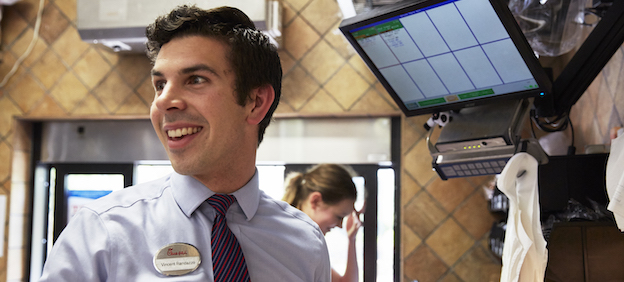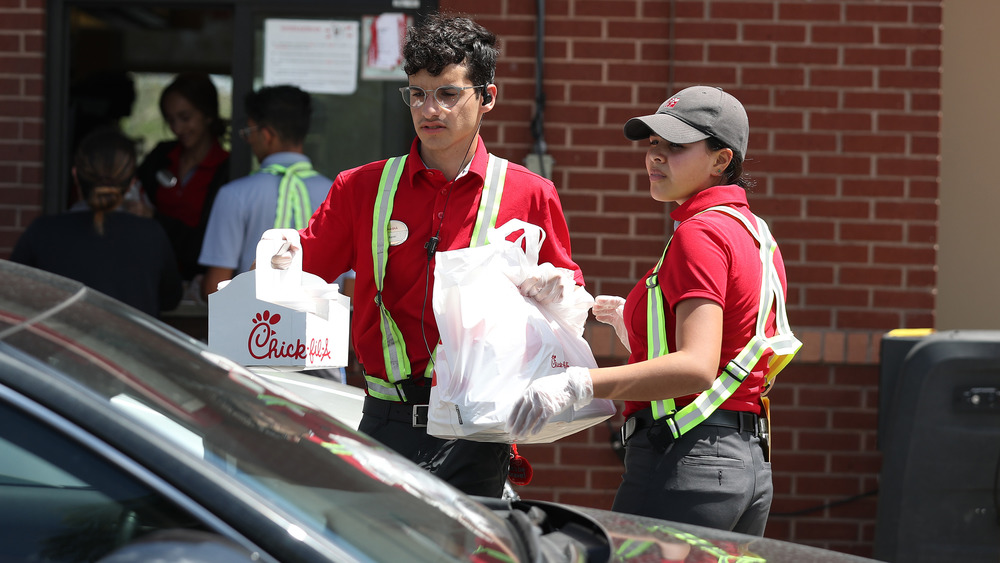Working at a fast-food restaurant might seem like an easy gig to some, but recent revelations from former employees have shed light on the harsh realities faced by many in this industry.
One such revelation comes from Elsa, a former Chick-Fil-A employee, who took to TikTok to share her troubling experiences.
Her video, which has garnered over 515,000 views, highlights issues ranging from inadequate winter clothing to extreme summer heat, all without proper breaks.
Elsa’s Viral TikTok Revelation
Elsa’s Experience

Elsa, a teacher and content creator on TikTok under the handle @semihippieteacher, worked at Chick-Fil-A for two years.
In her viral video, she exposes the difficult conditions employees endure.
The video starts with a clip of a Chick-Fil-A worker shivering outside without a jacket, with a voiceover stating, “People are mad at Chick-Fil-A for leaving their employees outside in the cold without providing winter clothing.”
Elsa then confirms, “The jacket part is absolutely true. They would not let us wear our own jackets because it didn’t have the Chick-Fil-A branding on it. Instead, if we wanted a jacket, we had to pay for it out of our own paychecks.”
Elsa’s detailed recount of her experience is not an isolated incident.
Many former employees have shared similar stories, painting a broader picture of the working conditions at Chick-Fil-A.
Winter Struggles
Winter was particularly challenging for Elsa and her colleagues.
They were often required to work outside in freezing temperatures for extended periods.
“They would have us out there for like, two hours straight and it was freezing,” Elsa recalls.
Employees were not allowed to wear their personal jackets because they did not have Chick-Fil-A branding.
This policy forced them to purchase branded jackets with their own money if they wanted any protection from the cold.
Such conditions are not only uncomfortable but can also pose serious health risks, which raises questions about the company’s policies and concern for employee well-being.
Summer Hardships
As challenging as winter was, Elsa asserts that summer was even worse.
She worked in Oklahoma, where temperatures and humidity can reach extreme levels.
“I was working at a Chick-Fil-A in Oklahoma where in the summertime, it gets super hot and the humidity is ridiculous,” she explains.
The uniforms, consisting of gray slacks and red polos, were not designed for such harsh weather.
“It’s really hot inside of them,” Elsa notes, highlighting the physical discomfort employees endured.
Elsa recounts a particularly severe incident: “One time I was scheduled to go outside and I was out there for two hours straight with no break. They gave us walkie-talkies to let the people inside know that we needed a break. I was doing that. Nobody was answering.”
Lack of Breaks and Response to Health Issues
Incident of Severe Heat Exhaustion
During one especially hot summer day, Elsa experienced severe heat exhaustion.
“I was sweating profusely, I was panting, and the world around me was starting to look black. My body was starting to shake,” she recounts.
Customer Reactions
Customers often noticed Elsa’s distress and tried to help.
Their reactions ranged from expressing concern to actively seeking help from the restaurant’s management.
“The customers as they were coming up to me were noticing I wasn’t feeling well,” Elsa recalls.
One particular customer took it upon herself to notify the staff inside.
“This one lady was like, ‘Oh my God, whenever I come around the drive-thru I’m gonna let the people inside know that you are feeling awful.’ And yet, no one came to check on me,” Elsa recounts.
These interactions highlight how visibly distressed employees can impact customer perception and potentially harm the brand’s image.
Management’s Response

When a manager finally came to check on Elsa, his response was far from reassuring.
“I couldn’t go inside because I would get in trouble for leaving the post where I was supposed to stand,” Elsa explains.
Eventually, she asked her manager to take her spot temporarily.
He complied but quickly sought relief himself.
“Within five minutes of my manager standing outside, taking my spot, he [was on the] walkie-talkie like, ‘hey, when is somebody gonna take my spot?’” Elsa says.
Elsa’s frustration was palpable: “I was about to pass out and all this man cared about was for either me or someone else to come back outside,” she vents.
Broader Workplace Issues at Chick-Fil-A
Harassment Incident

Elsa also faced harassment during her time at Chick-Fil-A.
She recounts a disturbing incident involving a middle-aged male customer.
“One time, a male middle-aged customer noticed me while in the drive-thru,” she recalls.
After leaving the drive-thru, the man called the store and asked to speak with her.
“‘Hey, I forgot to get your number in the drive-thru,’” he said.
Elsa responded, “‘I’m 17. I can’t do that,'” but the man persisted, saying, “‘Oh that’s not too bad. Can I still have it?'”
Such incidents highlight the additional risks and discomforts that young employees can face, often without adequate support from their employers.
Peer Experiences

Elsa’s story resonated with many others who shared their own experiences in the comments.
One user commented, “I worked for In-n-Out. They forgot me in 100 degree heat and I ended up passing out. The customer I was with was a nurse though so win.”
Another person shared, “Worked at Chick-Fil-A and was sent to do outside drive-thru when it was FREEZING RAIN. Soaked through all my clothes and my skin stayed cold for 24 hours.”
These anecdotes emphasize that Elsa’s experiences are part of a larger pattern of challenging working conditions in the fast-food industry.
Legal and Ethical Implications
The working conditions described by Elsa raise significant legal and ethical questions.
Labor laws are clear about the need for breaks and appropriate working conditions.
However, the experiences shared by Elsa and others suggest that these regulations are not always adhered to.
Forcing employees to buy branded jackets also raises questions about the fairness and legality of such policies.
Employees should not have to incur additional costs to comply with uniform requirements, especially when those uniforms are necessary for their health and safety.
Ethically, companies have a responsibility to ensure the well-being of their employees.
The conditions described by Elsa indicate a failure to prioritize employee health and safety, which is a serious ethical concern.
Chick-Fil-A’s Corporate Response
Company Policy on Uniforms and Breaks

Chick-Fil-A has not officially responded to Elsa’s specific claims, but their general policy mandates that employees adhere to uniform standards, which includes branded outerwear.
However, this policy does not account for the financial burden it places on employees.
Break policies at Chick-Fil-A, as described by Elsa, appear inconsistent with labor laws.
The lack of timely breaks during extreme weather conditions points to a need for better enforcement and oversight.
Analyzing how these policies align with employee experiences reveals significant gaps that need to be addressed to ensure compliance and employee safety.
The Role of Social Media in Highlighting Workplace Issues
Power of Viral Content
Social media platforms like TikTok have become powerful tools for employees to share their stories and advocate for better working conditions.
Elsa’s video is a prime example of how viral content can bring attention to important issues.
The reach and impact of such videos can prompt companies to take action and address the concerns raised by employees.
In many cases, public pressure can lead to significant changes in corporate policies and practices.
Other viral content highlighting similar issues has also resulted in increased awareness and, in some instances, tangible improvements in working conditions.
Community Support
The support from online communities plays a crucial role in amplifying these stories and holding companies accountable.
Comments, shares, and likes help spread the message and build momentum for change.
Elsa received considerable support from viewers who shared their own experiences and expressed solidarity.
This community backing can be a powerful force in advocating for workers’ rights.
As more people become aware of these issues, the collective demand for better working conditions grows stronger, potentially leading to industry-wide improvements.
Conclusion
Elsa’s story provides a stark look into the challenging working conditions faced by many fast-food employees.
From enduring extreme weather without proper breaks to dealing with harassment, her experiences highlight significant issues that need addressing.
The importance of employee well-being cannot be overstated.
Companies like Chick-Fil-A must take these concerns seriously and work towards creating a safer, more supportive environment for their workers.
As consumers, we also have a role to play.
By staying informed and advocating for better practices, we can contribute to meaningful changes that benefit employees across the industry.

